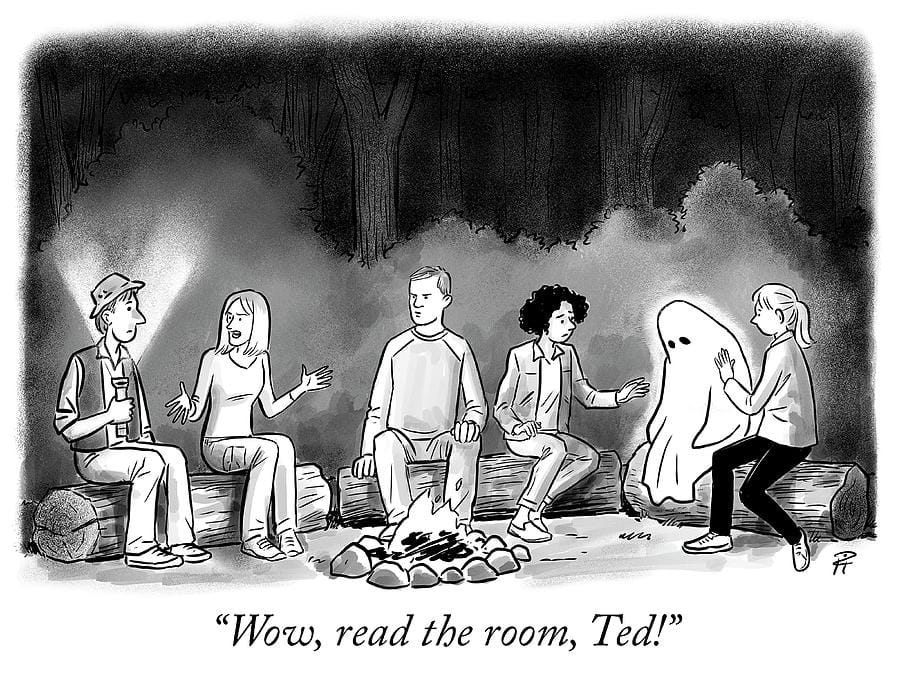The oft-cited Mehrabian data that 60-93% of communication occurs nonverbally is a quantifiable neurocognitive phenomenon. The ability to read the room is a masterful skill that doesn’t rely on guesswork. It’s a neuropsychological dynamic between individuals in which our brains are rapidly surveying the room for cues and making inferences about the vibe (Peng et al., 2024).
This ability to understand the social dynamics around you is deeply rooted in our evolutionary hardwiring for survival what neuroscientists call “social prediction coding.” Your brain should actively observe a space when you read the room. As you look around your brain is running a lightning-fast neural network, cross-referencing thousands of micro-social signals: pupils dilating, vocal timbre shifts, even the nanosecond delays in response times. Today, we will focus on mastering the ability to read the room in 30 seconds or less. These skills can be adapted whether you’re on a first date or collaborating on a project. Let’s get started!

Learning to “read the room” in 30 seconds or less is a valuable social skill that helps you gauge the emotional tone, social dynamics, and appropriateness of your words or actions in any given situation. Our team gathered data from readers regarding how difficult it was to learn how to read the room. Their concerns ranged from dating, workplace interactions, streaming, to overall social awkwardness. Our team developed this Step-By-Step Guide that will empower you to practice mastering the skill that will change social dynamics.
Total Time: 30 Seconds
Step 1: Observe the Baseline (5 Seconds)
To read the room effectively, start by scanning the environment carefully before speaking or acting. Pay attention to body language, noticing whether people seem open and engaged or closed off and uncomfortable. Look for facial expressions like smiles, frowns, or distracted glances, which reveal the emotional tone. Assess the energy level—whether the group is lively and talkative or quiet and reserved. This quick scan helps you understand the unspoken mood before you engage further.
Step 2: Listen for Verbal & Non-Verbal Cues (10 Seconds)
When learning to read the room, listen not just to what people say but how they say it—tone, pacing, and enthusiasm matter. Notice if responses are short and dismissive or engaged and detailed. Watch for subtle cues like sighs, forced laughter, or awkward pauses, which signal discomfort. If people keep glancing away or checking their phones, they may not be fully present. These clues help you adjust your approach before you speak.
Step 3: Match the Vibe (5 Seconds)
A key part of how to read the room is mirroring the dominant energy level and tone once you’ve assessed it. If the group is joking, keep things light; if they’re serious, stay focused. Test the waters with a neutral comment to gauge reactions before diving into deeper topics. Avoid being louder or quieter than everyone else. Striking a balance is key. Learning how to adapt quickly prevents awkward mismatches in conversation flow.
Step 4: Avoid Social Pitfalls (5 Seconds)
To successfully read the room, be mindful of oversharing your own business. Trauma-dumping or dominating the conversation can alienate others. If someone seems uncomfortable, pivot the topic or give them space. Respect personal boundaries, avoiding intrusive questions or physical contact unless clearly welcomed. Reading reactions in real time helps you avoid unintentional social blunders.
Step 5: Adapt or Exit (5 Seconds)
The final step to read the room is knowing when to adapt or exit gracefully. If you misread the situation, correct course with a light apology or topic shift. If the vibe is hostile or disengaged, it’s okay to politely exit the conversation. Flexibility is crucial when you’re reading the room and sometimes the best move is to step back and observe more before reengaging.
3 Quick Moves
| Time Frame | Brain System Involved | Actionable Behavior |
| 0–10 sec | Selective Attention | Scan body clusters (crossed arms + angled torso = resistance) |
| 10–20 sec | Empathy + Mirror Neurons | Listen for tone mismatches (tense laughter = discomfort) |
| 20–30 sec | Theory of Mind + Context | Observe gaze aversion during tension (likely disagreement) |
How to Read the Room on a Date
Observe Before Speaking: Scan their posture, eye contact, and energy—are they leaning in (engaged) or checking their phone (distracted)? Mirror their tone (playful/serious).
Ask Open-Ended Questions: “What’s your favorite story about [topic they mentioned]?” Listen actively—their enthusiasm (or lack thereof) guides your next move.
Pause & Check Reactions: After sharing something, watch their facial response. A smile? Expand. A pause? Lighten the mood or pivot.
Embrace Silence Comfortably: Nervous? Say, “I’m just enjoying this vibe—what’s a random thought you had today?” Silence isn’t failure; it’s space to recalibrate.
Exit Gracefully if Needed: If energy flatlines, propose a context shift: “This café’s vibe is cozy, but want to walk? I’d love your take on the neighborhood.”
Pro Tip: Pre-prepare 3 “energy-shifter” questions (e.g., “What’s your weirdest talent?”) to deploy if conversation lulls. Your brain’s social prediction system improves with exposure—each date is data.

Learn to Read the Room in the Workplace
When tensions rise in a project meeting, your ability to decode the social landscape becomes critical. Start by scanning micro-cues you’re looking for furrowed brows, clipped tones, or defensive postures that can signal brewing conflict. Notice who’s dominating the conversation and who’s withdrawn; power imbalances often fuel friction. If emotions escalate, pause and recalibrate. A well-timed, neutral interjection like “Let’s revisit the core goal here” can reset the tone. Mirror the group’s energy but dial it back if voices are raised. Be the voice of calm reason, it shows such confidence under stress that you’ll admire in yourself. Respond with a clear, measured calm tone. Watch for alliance cues and reactions to what you’ve said such as side glances, subtle nods to identify unspoken factions.
When stuck at an impasse, name the dynamic: “I sense we’re circling. Should we table this and revisit with fresh data?” This meta-awareness often defuses tension. Post-meeting, cornerstone colleagues 1:1 to realign. Your social radar sharpens with each crisis navigated expertly.
Pro move: Track how conflict patterns shift across personalities. Engineers vs. Marketing Team often clash on risk tolerance. Adapt your mediation style according to your audience. The more you learn about them and their concerns, the easier it becomes to communicate.

Emotional Intelligence is the Key to Reading the Room
Frequently Asked Questions
What does it mean to say “read the room”?
To “read the room” means quickly assessing a social situation by interpreting verbal cues, body language, and emotional tones to respond appropriately. It’s about sensing the collective mood and adapting your behavior accordingly.
What does “read the room” mean in a relationship?
In relationships, when someone tells you to read the room it refers to picking up on your partner’s unspoken emotions and needs. Over 60% of language is nonverbal. That means your partner will not always speak their mind to provide you clarity. When you learn how to read the room it means noticing subtle shifts in their mood, tone, or body language to respond with empathy and understanding.
What is it called when someone is socially unaware?
To be socially unaware is to be unable to read the room or being oblivious. Social unawareness is often called “social blindness” or “low social intelligence.” In clinical contexts, it may relate to conditions like autism spectrum disorder (ASD) or social (pragmatic) communication disorder (SCD).
What is it called when someone can’t read the room?
Someone who struggles to read social cues is often described as “socially tone-deaf” or having “poor situational awareness.” Psychologists may call it “social cognition impairment” when severe and in clinical contexts it may indicate social disorders that require an evaluation by a professional/
Further Reading on Social Power Dynamics











